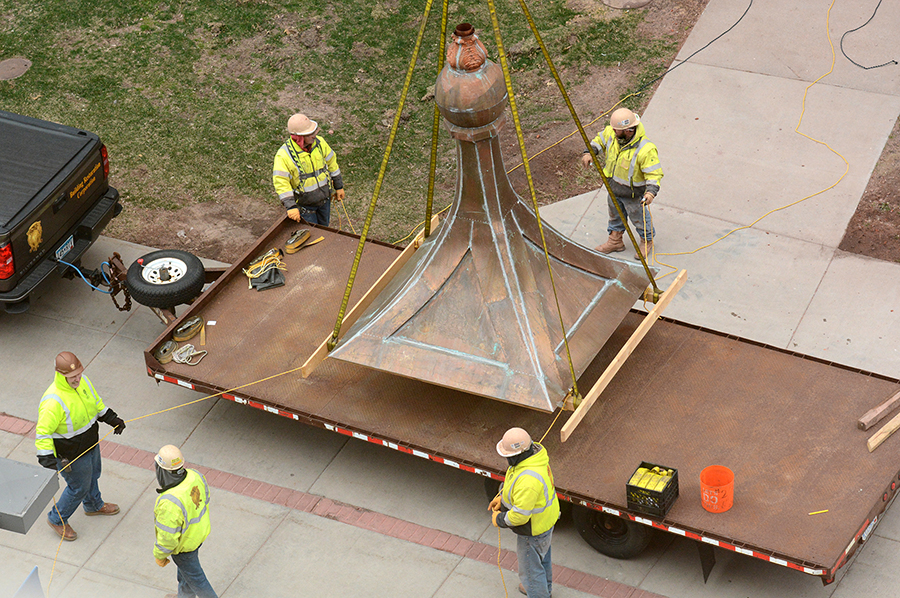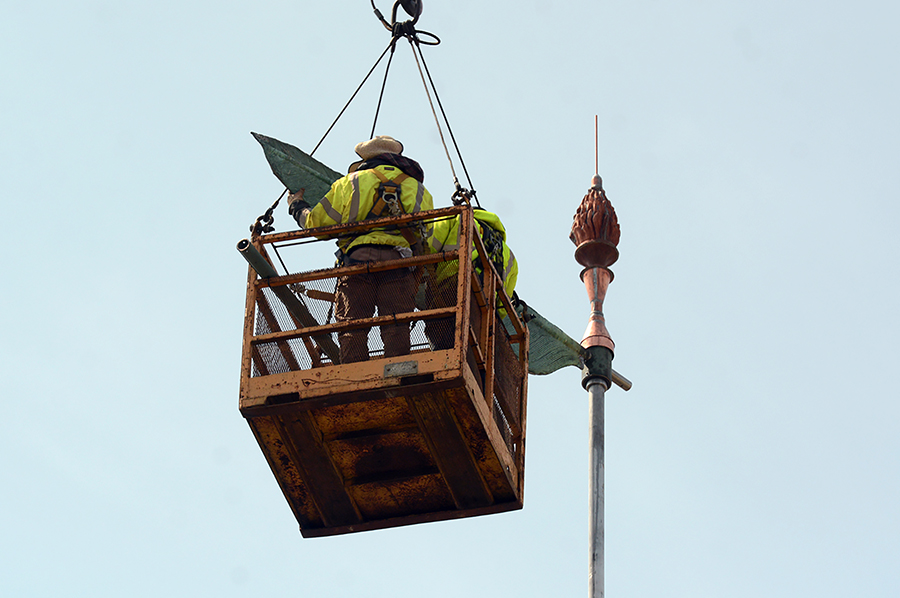A high, shining symbol of the belief that education is a way forward for the people of Wisconsin and beyond has returned to the campus of University of Wisconsin-Stout.
The quill, which sits atop Bowman Hall, 135 feet above campus and downtown Menomonie, was reinstalled Thursday, April 23.
 The 122-year-old weathervane was removed for restoration Aug. 27, 2019, as part of an $8.95 million state-approved building project.
The 122-year-old weathervane was removed for restoration Aug. 27, 2019, as part of an $8.95 million state-approved building project.
“The quill is such a visible and memorable part of Bowman Hall. People know it and understand its importance and history in the community,” said Mike Bowman, project manager for Facilities Management at UW-Stout.
Bowman Hall, with its brick Clock Tower and bells, was built by university founder James Huff Stout, who also was a state senator. He was a strong believer in education, symbolized by the replica of a traditional writing instrument, topped with a molded copper flame or torch, at the most visible point of his building.
The quill should stand for many more decades to come, thanks to the efforts of contractor Building Restoration Corp. of Roseville, Minn. The quill’s two copper plates were patched, shored up with a new skeleton and resoldered at the top seam, said Dan McPhillips, Sheet Metal Shop manager with BRC.
 “The main seam had separated, so moisture had gotten inside and had rusted the steel skeleton. That was bad. We’re happy to see it back in place, and it looks good. We’re very proud of all he work we’ve done on the building,” McPhillips said.
“The main seam had separated, so moisture had gotten inside and had rusted the steel skeleton. That was bad. We’re happy to see it back in place, and it looks good. We’re very proud of all he work we’ve done on the building,” McPhillips said.
Just like when it was new in 1898, the quill will spin with the wind. The old turning mechanism had failed. A new, ball bearing system was precision-milled from an 80-pound block of stainless steel by BRC’s Tony Selle.
The quill consists of a “feather” about nine feet long and two feet high and a “pen” about 4½ feet long that is weighted to provide balance.
The process of reinstalling the quill included first hoisting a tapered copper cupula that sits atop the roof, followed by installing the ball bearing system, which was packed with grease and sealed; followed by reinstalling the two-foot-high torch; and then the quill, which fits into a central pole. The copper torch also was refurbished and sealed on the inside with liquid plastic to block moisture.

“There was a bit of concern about sliding the entire cupula assembly over the top of the spire rod that they previously set a couple months ago. Any twisting or movement side to side could have ripped the spire down and/or compromised the cupula. The process went flawless, though,” Bowman said.
Bowman was happy to see quill and cupula resetting go so smoothly.
“One of the biggest challenges was fabricating everything at their shop to make it fit perfectly in the field,” Bowman said. “Great construction workers and technicians worked on this and made it happen.”
High over the city with about 10 mph winds, a team of harnessed workers on the rooftop corners used ropes attached to the cupula to help guide it over the pole, said McPhillips, who was on the roof.

Officials from BRC, the state Division of Facility Development and Management, Isthmus Architecture Inc. and UW-Stout were on hand, along with some spectators, to see a crane lift workers and project components to the roof, which was framed with scaffolding. The campus is devoid of students because of the COVID-19 pandemic.
 “In high rise steel construction there is a term called ‘topping out,’ and ironworkers long have a history of making a big deal about ‘topping out.’ This is the point in a high rise or steel construction project where they set the last piece of structural steel. This, in some ways, was like the ‘topping out’ process of this project. They are very nearly complete with all the brick work, and this being the highest point on this project it was a big milestone,” Bowman said.
“In high rise steel construction there is a term called ‘topping out,’ and ironworkers long have a history of making a big deal about ‘topping out.’ This is the point in a high rise or steel construction project where they set the last piece of structural steel. This, in some ways, was like the ‘topping out’ process of this project. They are very nearly complete with all the brick work, and this being the highest point on this project it was a big milestone,” Bowman said.
The cupula has new, heavier gauge copper. The old copper had failed, McPhillips said.
Building restoration project began in 2018
The top-of-the-tower project includes a new copper roof, installed last fall, which already has begun to lose its shine and will eventually brighten to the same patina as the quill, Bowman said.
The entire building project, which began in spring 2018, is expected to wrap up in late May or early June, according to Bowman. Most of the work is on the exterior, including repointing of all exterior mortar joints, replacing about 30,000 worn bricks, repairing and replacing many of the brownstone accents and installing new windows and doors.
Because of the exterior work, the project was halted during the winters.
The state DFD will eventually incorporate a new, modern lightning protection system. It will update the old system, which was discovered to be nonfunctioning.

Erected in 1898
The quill for many years has been part of the university’s official logo.
It dates to 1898. Construction on Bowman Hall — then Stout Manual Training Institute — began in July 1897 and largely wrapped up in April of 1898. A report in the March 11, 1898, Dunn County News said the quill/weathervane was “soon to be erected on top of the tower.”
The building was constructed after fire burned down the previous facility, just four years old, and the adjoining high school on the same site Feb. 2, 1897, according to the university history book “An Idea Comes of Age: UW-Stout, 1891-1916.”
Bowman Hall is in the National Register of Historic Places.
###
Photos
The 122-year-old Bowman Hall quill and the torch above it have been restored. The copper on the cupula, which sits on the new roof, had to be replaced.
Workers for Building Restoration Corp. restore the quill in their shop in Minnesota.
The rebuilt cupula sits on a trailer April 23 before being lifted by a crane to the top of Bowman Hall and set in place.
The cupula is maneuvered into place by a crane operator and workers on top of Bowman Hall. The cupula had to fit over a metal pole and then be fastened to the roof.
The quill is loaded into a bucket before being lifted by a crane to the top of Bowman Hall.
The feather end of the copper quill, a weathervane, is fitted into the central pole above Bowman Hall.







